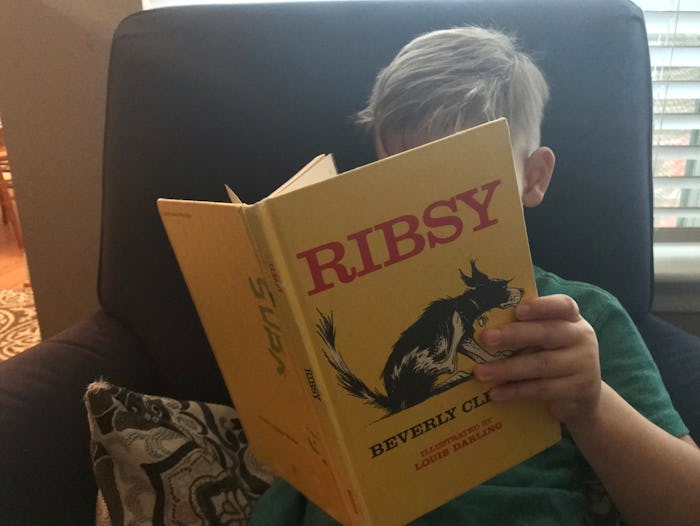Life

Beverly Cleary's Books Have Shaped Children’s Lives For Generations
The author passed away at her home in California at age 104.
Beverly Cleary, the beloved author who published her first children’s book, Henry Huggins, in 1950, died yesterday at the age of 104. She wrote dozens of stories, including several about the iconic sisters Ramona and Beezus and motorcycle-riding mouse named Ralph. Romper published this ode to Cleary’s work on the occasion of her 103 birthday in 2019.
When I was a preteen, I wore out copies of every Ramona Quimby book I could get my hands on. The playful, inquisitive, and courageous adventures of Ramona were written so eloquently and reflected themes and challenges I had in my own life. The mastermind behind my beloved childhood-favorite book character has become a living legend since writing her debut novel, Henry Huggins, in 1950. As she celebrates her 103rd birthday, it is worth nothing that what makes Beverly Cleary important is not the longevity of her life and career, but how her stories have stood the test of time, creating a lasting impact that readers carry with them throughout their lives.
Liz Maurer, former director of programming for the National Women's History Museum and current Curator of Education at a federal museum, says that as a woman coming of age in the late 1970s, Cleary's stories reflected versions of herself that she did not see in other authors’ work. "Cleary’s characters had more nuance and depth. Golly gee, the boys and girls were actually friends. They faced more interesting and relatable problems. Henry Huggins’ dog Ribsy was lost for an entire book. Beezus and Ramona’s dad lost his job, and their mother had to go to work. Their dad experienced depression as a result of job loss. My dad was laid off a few years later. Cleary gave me a model of how to cope," she tells Romper.
"I think it’s also important to say that when Cleary started writing, most middle-class white mothers of elementary school age children did not work outside of the home. At least not in my neighborhood. Yet, this was the decade after Title IX, and all of a sudden people started asking girls what they wanted to be when they grew up," Mauer continues, explaining how Cleary's writing influenced her generation. "As a Generation X kid, Beverly Cleary was almost the only piece of popular culture that depicted an employed mom in my socio-demographic." She says that as a parent now to three children, she draws on Cleary's character of Mrs. Quimby as a model that reminds her that it is "OK to be normal."
Cleary says she has no formal creative writing training. Her stories are a product of what she says is a writing process that is done "very messily." "I usually start with a couple of ideas, not necessarily at the beginning of the book, and I just write," she told one interviewer. It is this type of free-flowing style that allows the characters of her book to live lives that readers can really understand and see themselves in. Cleary also notes that her stories don't take place in a particular time, which could attribute to their long-lasting popularity, as well as her work's easy transition to popular plays and films.
Romper lifestyle editor Samantha Darby says that Cleary's stories not only served as an inspiration to her in childhood, but she hopes they will play the same role for her own daughters. "All of my favorites Beverly Cleary characters were kids who had a tendency to mess up — like Ramona and Beezus. So I felt very 'seen' and like the books were written for me," she says. "But they also didn't feel juvenile and I always kind of felt like a big kid checking out a Beverly Cleary book from the library. I hope my own girls see themselves in her stories and find a sense of comfort in her books like I did!"
Each April, kids nationwide participate in a program inspired by Cleary's character, Ramona, who spearheads the same organization, although fictional, in her book Ramona Quimby, Age 8. According to the description on the program's website, the D.E.A.R. (or, Drop Everything And Read) program is a national celebration of reading where families are encouraged to spend 30 minutes (or more) doing nothing but reading together on April 12. I remember participating in D.E.A.R day as an elementary schooler in the mid-1990s thanks to my wonderful school librarian, Mr. Thomas, who saw the importance of programs like D.E.A.R and used his influence to help spread the love of reading through his students. As librarians and teachers across the country continue to foster the importance of reading through participating in D.E.A.R., they are spreading the influence of Cleary's work far and wide through each generation.
Bethany Austin, a fifth grade teacher in Texas, is one such educator. She recognizes the importance of Cleary's work and her lasting influence on children. She often recommends Cleary's books to her students who may need help connecting. "Cleary's work is timeless. Children can still walk a mile in Ramona's shoes or see a classmate with a personality just like hers," she says.
When an author can reach through the pages of a book and grab the attention of young readers with lovable messy, imperfect characters like Cleary has, they create lasting impact that spans generations. Keeping such work alive and well is truly invaluable.
This article was originally published on